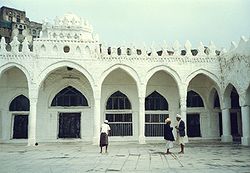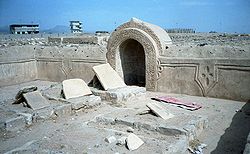
Islam in Yemen
Encyclopedia


630
Year 630 was a common year starting on Monday of the Julian calendar. The denomination 630 for this year has been used since the early medieval period, when the Anno Domini calendar era became the prevalent method in Europe for naming years.- Byzantine Empire :* Croats and Serbs settle in the...
when it was introduced into the region by Ali ibn Abu Talib when Prophet Muhammad
Muhammad
Muhammad |ligature]] at U+FDF4 ;Arabic pronunciation varies regionally; the first vowel ranges from ~~; the second and the last vowel: ~~~. There are dialects which have no stress. In Egypt, it is pronounced not in religious contexts...
was still alive. It was during this period that the mosque
Mosque
A mosque is a place of worship for followers of Islam. The word is likely to have entered the English language through French , from Portuguese , from Spanish , and from Berber , ultimately originating in — . The Arabic word masjid literally means a place of prostration...
s in al Janad and the great mosque in San'a were built. Yemenis are divided into two principal Islamic religious groups: 50-55% Sunni and 42%-47% Shi'a. The denominations are as follows: 50-55% primarily of the Shafi'i and other orders of Sunni Islam. 40-45% of the Zaidi order of Shi'a Islam, 2-5% of the Ja'fari and Western Isma'ili orders of Shi'a Islam. The Sunnis are predominantly in the south and southeast. The Zaidis are predominantly in the north and northwest whilst the Jafaris are in the main centres of the North such as Sana'a and Ma'rib. There are mixed communities in the larger cities.
The Zaidis of the northern highlands dominated politics and cultural life in northern Yemen for centuries; with unification, and the addition of the south’s almost totally Shafi'i population, the numerical balance has shifted dramatically away from the Zaidis. Nevertheless, Zaidis are still overrepresented in the government and, in particular, in the former North Yemeni units within the armed forces. Except for a small politically motivated clerical minority, religiously motivated violence is neither incited nor tolerated by the Islamic clergy. However, Wahhabi and Salafi from Saudi Arabia and anti-Shiite stance of Iraqis who support Saddam, are influencing the government. There are clashes between the government and primarily Zaidi forces.
Public schools provide instruction in Islam but not in other religions, although Muslim citizens are allowed to attend private schools that do not teach Islam. In an effort to curb ideological and religious extremism in schools, the government does not permit any courses outside of the officially approved curriculum to be taught in private and national schools. Because the government is concerned that unlicensed religious schools deviate from formal educational requirements and promote militant ideology, it has closed more than 4,500 of these institutions and deported foreign students studying there.
See also
- Islam by countryIslam by countryIslam is the world's second largest religion after Christianity. According to a 2009 demographic study, Islam has 1.57 billion adherents, making up 23% of the world population....
- Religion in YemenReligion in YemenVirtually all citizens of Yemen are Muslims, and belong to the Zaydi order of Shi'a Islam or to the Shafi'i order of Sunni Islam. There are also approximately 3,000 Christians, 400 Jews and an extreme minority of Hindus.-Islam:...
- Freedom of religion in YemenFreedom of religion in YemenThe Constitution of Yemen provides for freedom of religion, and the Government generally respected this right in practice; however, there were some restrictions. The Constitution declares that Islam is the state religion, and that Shari'a is the source of all legislation...

